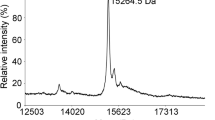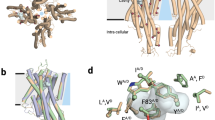Abstract
We have solved the high-resolution crystal structures of the Drosophila melanogaster alcohol-binding protein LUSH in complex with a series of short-chain n-alcohols. LUSH is the first known nonenzyme protein with a defined in vivo alcohol-binding function. The structure of LUSH reveals a set of molecular interactions that define a specific alcohol-binding site. A group of amino acids, Thr57, Ser52 and Thr48, form a network of concerted hydrogen bonds between the protein and the alcohol that provides a structural motif to increase alcohol-binding affinity at this site. This motif seems to be conserved in a number of mammalian ligand-gated ion channels that are directly implicated in the pharmacological effects of alcohol. Further, these sequences are found in regions of ion channels that are known to confer alcohol sensitivity. We suggest that the alcohol-binding site in LUSH represents a general model for alcohol-binding sites in proteins.
This is a preview of subscription content, access via your institution
Access options
Subscribe to this journal
Receive 12 print issues and online access
$189.00 per year
only $15.75 per issue
Buy this article
- Purchase on Springer Link
- Instant access to full article PDF
Prices may be subject to local taxes which are calculated during checkout




Similar content being viewed by others
References
Faingold, C.L., N'Gouemo, P. & Riaz, A. Ethanol and neurotransmitter interactions—from molecular to integrative effects. Prog. Neurobiol. 55, 509–535 (1998).
Mascia, M.P., Machu, T.K. & Harris, R.A. Enhancement of homomeric glycine receptor function by long-chain alcohols and anaesthetics. Br. J. Pharmacol. 119, 1331–1336 (1996).
Ikonomidou, C. et al. Ethanol-induced apoptotic neurodegeneration and fetal alcohol syndrome. Science 287, 1056–1060 (2000).
Lovinger, D.M. Alcohols and neurotransmitter gated ion channels: past, present and future. Naunyn Schmiedebergs Arch. Pharmacol. 356, 267–282 (1997).
Harris, R.A. Ethanol actions on multiple ion channels: which are important? Alcohol Clin. Exp. Res. 23, 1563–1570 (1999).
Mihic, S.J. et al. Sites of alcohol and volatile anesthetic action on GABA(A) and glycine receptors. Nature 389, 385–389 (1997).
Ye, Q. et al. Enhancement of glycine receptor function by ethanol is inversely correlated with molecular volume at position α 267. J. Biol. Chem. 273, 3314–3319 (1998).
Ueno, S., Wick, M.J., Ye, Q., Harrison, N.L. & Harris, R.A. Subunit mutations affect ethanol actions on GABA(A) receptors expressed in Xenopus oocytes. Br. J. Pharmacol. 127, 377–382 (1999).
Wick, M. et al. Mutations of γ-aminobutyric acid and glycine receptors change alcohol cutoff: evidence for an alcohol receptor? Proc. Natl. Acad. Sci. USA 95, 6504–6509 (1998).
Woodward, J.J. Ionotropic glutamate receptors as sites of action for ethanol in the brain. Neurochem. Int. 35, 107–113 (1999).
Krasowski, M.D. et al. Propofol and other intravenous anesthetics have sites of action on the γ-aminobutyric acid type a receptor distinct from that for isoflurane. Mol. Pharmacol. 53, 530–538 (1998).
Kash, T.L., Jenkins, A. & Harrison, N.L. Molecular volume determines the activity of the halogenated alkane bromoform at wild-type and mutant GABA(A) receptors. Brain Res. 960, 36–41 (2003).
Jenkins, A. et al. Evidence for a common binding cavity for three general anesthetics within the GABA(A) receptor. J. Neurosci. 21, U7–U10 (2001).
Li, C.M., Heatwole, J., Soelaiman, S. & Shoham, M. Crystal structure of a thermophilic alcohol dehydrogenase substrate complex suggests determinants of substrate specificity and thermostability. Proteins 37, 619–627 (1999).
Benach, J., Atrian, S., Gonzalez-Duarte, R. & Ladenstein, R. The refined crystal structure of Drosophila lebanonensis alcohol dehydrogenase at 1.9 Å resolution. J. Mol. Biol. 282, 383–399 (1998).
Xie, P., Parsons, S.H., Speckhard, D.C., Bosron, W.F. & Hurley, T.D. X-ray structure of human class IV σσ alcohol dehydrogenase. Structural basis for substrate specificity. J. Biol. Chem. 272, 18558–18563 (1997).
Niederhut, M.S., Gibbons, B.J., Perez-Miller, S. & Hurley, T.D. Three-dimensional structures of the three human class I alcohol dehydrogenases. Protein Sci. 10, 697–706 (2001).
Dwyer, D.S. & Bradley, R.J. Chemical properties of alcohols and their protein binding sites. Cell. Mol. Life Sci. 57, 265–275 (2000).
Eckenhoff, R.G. & Johansson, J.S. Molecular interactions between inhaled anesthetics and proteins. Pharmacol. Rev. 49, 343–367 (1997).
Franks, N.P., Jenkins, A., Conti, E., Lieb, W.R. & Brick, P. Structural basis for the inhibition of firefly luciferase by a general anesthetic. Biophys. J. 75, 2205–2211 (1998).
Ishizawa, Y., Pidikiti, R., Liebman, P.A. & Eckenhoff, R.G. G protein-coupled receptors as direct targets of inhaled anesthetics. Mol. Pharmacol. 61, 945–952 (2002).
Johansson, J.S., Scharf, D., Davies, L.A., Reddy, K.S. & Eckenhoff, R.G. A designed four-α-helix bundle that binds the volatile general anesthetic halothane with high affinity. Biophys. J. 78, 982–993 (2000).
Sachsenheimer, W., Pai, E.F., Schulz, G.E. & Schirmer, R.H. Halothane binds in adenine-specific niche of crystalline adenylate kinase. FEBS Lett. 79, 310–312 (1977).
Vogt, R.G. & Riddiford, L.M. Pheromone binding and inactivation by moth antennae. Nature 293, 161–163 (1981).
Campanacci, V. et al. Moth chemosensory protein exhibits drastic conformational changes and cooperativity on ligand binding. Proc. Natl. Acad. Sci. USA 100, 5069–5074 (2003).
Mosbah, A. et al. Solution structure of a chemosensory protein from the moth Mamestra brassicae. Biochem. J. 369, 39–44 (2003).
Kim, M.-S., Repp, A. & Smith, D.P. LUSH Odorant-binding protein mediates chemosensory responses to alcohols in Drosophila melanogaster. Genetics 150, 711–721 (1998).
Du, G. & Prestwich, G.D. Protein structure encodes the ligand binding specificity in pheromone binding proteins. Biochemistry 34, 8726–8732 (1995).
Sandler, B.H., Nikonova, L., Leal, W.S. & Clardy, J. Sexual attraction in the silkworm moth: structure of the pheromone-binding-protein-bombykol complex. Chem. Biol. 7, 143–151 (2000).
Laurence, C. & Berthelot, M. Observations on the strength of hydrogen bonding. Perspect. Drug Discov. Design 18, 39–60 (2000).
Lee, D. et al. NMR structure of the unliganded Bombyx mori pheromone-binding protein at physiological pH. FEBS Lett. 531, 314–318 (2002).
Rothemund, S., Liou, Y.C., Davies, P.L., Krause, E. & Sonnichsen, F.D. A new class of hexahelical insect proteins revealed as putative carriers of small hydrophobic ligands. Struct. Fold. Des. 7, 1325–1332 (1999).
Horst, R. et al. NMR structure reveals intramolecular regulation mechanism for pheromone binding and release. Proc. Natl. Acad. Sci. USA 98, 14374–14379 (2001).
Prestwich, G.D. Bacterial expression and photoaffinity labeling of a pheromone binding protein. Protein Sci. 2, 420–428 (1993).
Mascia, M.P., Trudell, J.R. & Harris, R.A. Specific binding sites for alcohols and anesthetics on ligand-gated ion channels. Proc. Natl. Acad. Sci. USA 97, 9305–9310 (2000).
Yamakura, T., Bertaccini, E., Trudell, J.R. & Harris, R.A. Anesthetics and ion channels: molecular models and sites of action. Annu. Rev. Pharmacol. Toxicol. 41, 23–51 (2001).
Bertaccini, E. & Trudell, J.R. Molecular modeling of ligand-gated ion channels: progress and challenges. Int. Rev. Neurobiol. 48, 141–166 (2001).
Miyazawa, A., Fujiyoshi, Y. & Unwin, N. Structure and gating mechanism of the acetylcholine receptor pore. Nature 423, 949–955 (2003).
Covarrubias, M., Vyas, T.B., Escobar, L. & Wei, A. Alcohols inhibit a cloned potassium channel at a discrete saturable site. Insights into the molecular basis of general anesthesia. J. Biol. Chem. 270, 19408–19416 (1995).
Borghese, C.M., Ali, D.N., Bleck, V. & Harris, R.A. Acetylcholine and alcohol sensitivity of neuronal nicotinic acetylcholine receptors: mutations in transmembrane domains. Alcohol Clin. Exp. Res. 26, 1764–1772 (2002).
Otwinowski, Z. & Minor, W. Processing of X-ray diffraction data collected in oscillation mode. Methods Enzymol. 276, 307–326 (1997).
Terwilliger, T.C. & Berendzen, J. Automated structure solution for MIR and MAD. Acta Crystallogr. D 55, 849–861 (1999).
Jones, T.A., Zou, J.Y., Cowan, S.W. & Kjelgaard, M. Improved methods for building protein models in electron density maps and the location of errors in these models. Acta Crystallogr. A 47, 110–119 (1991).
Collaborative Computational Project, Number 4. The CCP4 suite: programs for protein crystallography. Acta Crystallogr. D 50, 760–763 (1994).
Brünger, A.T. et al. Crystallography & NMR system: a new software suite for macromolecular structure determination. Acta Crystallogr. D 54, 905–921 (1998).
Laskowski, R.A. PROCHECK: a program to check the stereochemical quality of protein structures. J. Appl. Cryst. 26, 283–291 (1993).
Bodenhausen, G. & Ruben, D.J. Natural abundance N-15 NMR by enhanced heteronuclear spectroscopy. Chem. Phys. Lett. 69, 185–189 (1980).
Kraulis, P.J. MOLSCRIPT: a program to produce both detailed and schematic plots of protein structures. J. Appl. Crystallogr. 24, 946–950 (1991).
Esnouf, R.M. Further additions to MolScript version 1.4, including reading and contouring of electron-density maps. Acta Crystallogr. D 55, 938–940 (1999).
Merritt, E.A. & Bacon, D.J. Raster3D: photorealistic molecular graphics. Methods Enzymol. 277, 505–524 (1997).
Acknowledgements
We thank M. Churchill for invaluable advice on crystallography studies and H. Robinson for MAD data collection at Brookhaven National Laboratory. X-ray crystallography facilities and NMR spectrometers were purchased with funds provided by Howard Hughes Medical Institute and their operation is supported by the University of Colorado Cancer Center Core Grant. S.W.K. is supported by an American Heart Association Predoctoral Fellowship. This work is supported by an American Heart Association Development Grant and a grant from the US National Institutes of Health, National Institute on Alcohol Abuse and Alcoholism to D.N.M.J.
Author information
Authors and Affiliations
Corresponding author
Ethics declarations
Competing interests
The authors declare no competing financial interests.
Rights and permissions
About this article
Cite this article
Kruse, S., Zhao, R., Smith, D. et al. Structure of a specific alcohol-binding site defined by the odorant binding protein LUSH from Drosophila melanogaster. Nat Struct Mol Biol 10, 694–700 (2003). https://doi.org/10.1038/nsb960
Received:
Accepted:
Published:
Issue Date:
DOI: https://doi.org/10.1038/nsb960
This article is cited by
-
A new non-classical fold of varroa odorant-binding proteins reveals a wide open internal cavity
Scientific Reports (2021)
-
Aedes aegypti Odorant Binding Protein 22 selectively binds fatty acids through a conformational change in its C-terminal tail
Scientific Reports (2020)
-
Gas sensors based on mass-sensitive transducers. Part 2: Improving the sensors towards practical application
Analytical and Bioanalytical Chemistry (2020)
-
The Drosophila odorant-binding protein 28a is involved in the detection of the floral odour ß-ionone
Cellular and Molecular Life Sciences (2020)
-
Complete NMR chemical shift assignments of odorant binding protein 22 from the yellow fever mosquito, Aedes aegypti, bound to arachidonic acid
Biomolecular NMR Assignments (2019)



